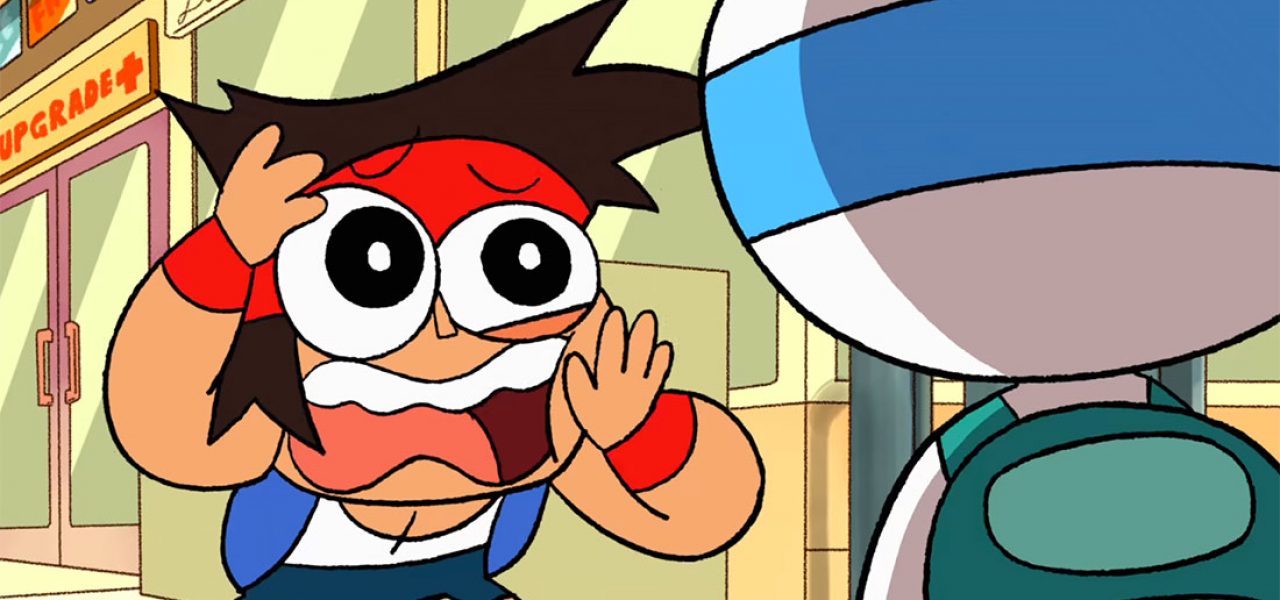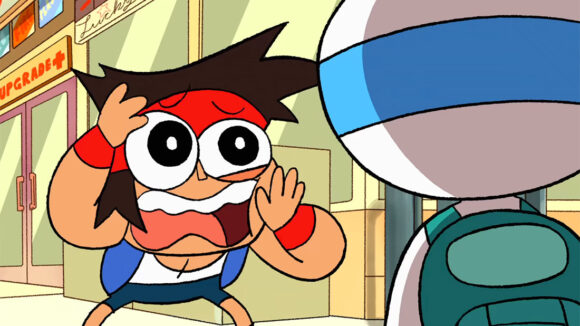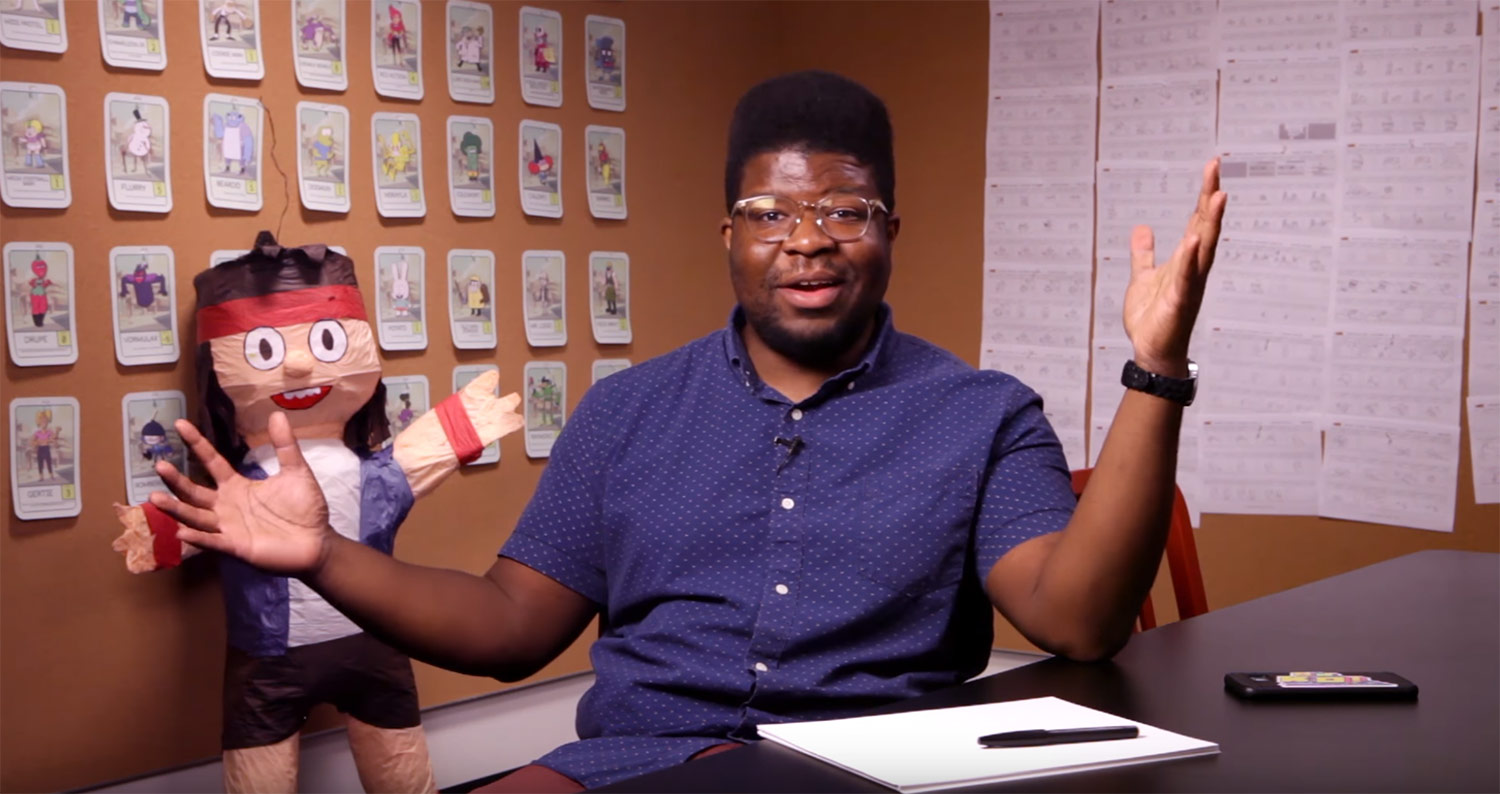

‘OK K.O.’ Creator Ian Jones-Quartey: “We Try Not To Have The Show Traffic In Cynicism”
At San Diego Comic-Con International in July, there was a buzz around Cartoon Network’s OK K.O.! Let’s Be Heroes. The third season had just started airing, and it was announced at the convention that Sonic the Hedgehog would make a guest appearance in a forthcoming episode. Fans were ecstatic.
Weeks later, the series’s creator Ian Jones-Quartey revealed that OK K.O.! would not be renewed for a fourth season. Cartoon Network had pulled the plug on K.O., the sweet little boy who dreams of becoming a superhero, and the zany world of heroes, ninjas, villains, demons, and aliens that he inhabits. Fans were crushed.
It was shortly after the Sonic announcement that Cartoon Brew caught up with Jones-Quartey at Cartoon Network’s studio in Burbank. With the show’s end still unannounced, our conversation focused on the show’s genesis and creative approach, Jones-Quartey’s influences, and the reason why he likes things to look “wrong.”

Cartoon Brew: How long was the Sonic appearance in the works?
Ian Jones-Quartey: We’ve been working on that since our first season. Our series executive Conrad Montgomery brought it up to us — both of us love crossovers. I was a huge fan of Sonic, but also the crew that I assembled: we all had a piece of Sonic fandom at our desks.
You’ve had some deep cuts in terms of guest stars: Captain Planet and the Ghoul School from Scooby-Doo, and the characters from your webcomic RPG World!
The whole show is a celebration of animation fan energy. If we get the opportunity to work with properties and characters we really like, we’re gonna take it.
It took a long time just to get the [Sonic] deal, but everybody has been super enthusiastic. Working with Sega was really cool, because this is their big character. We had an awesome pitch with them: the current head of the Sonic team, Takashi Iizuka, gave us notes on things that Sonic can do, things Sonic can’t do.
Speaking of Sega, anime is such a clear influence on the show. I read that one of the co-founders of Studio Trigger storyboarded something?
Yeah! The intro is boarded by [Hiroyuki] Imaishi-san. It was a huge honor, to the point where people will be like, “Oh, let’s change the intro for some special thing,” and I’m like, “No, we’re never changing it!”
If you could have any character guest-star on OK K.O., who would it be?
I really wanted to make a Space Ghost crossover — not just Space Ghost Coast to Coast, but the original Space Ghost. They’re cheesy, but I really used to love them when I was a kid.
What shows have most influenced you?
My number one is always going to be Looney Tunes. But then I was also really inspired by Dexter’s Lab, Powerpuff Girls, Samurai Jack. That Hanna-Barbera-meets-anime feeling is definitely the thing I’m most into.
OK K.O. is very un-ironic. K.O. is such a joyful person, there’s no cynicism, no winking at the audience, and it’s so refreshing. Even with the villains, you kind of root for them.
When I was a kid, every show I watched, I loved the villains more than the heroes. Overall, we try not to have the show traffic in cynicism. You mentioned the Captain Planet crossover — it’s really in vogue to evoke old things to roll your eyes at them and sneer at them, and we really don’t want to do that.
Is your affinity for villains the reason why you introduced T.K.O. [a dark version of K.O.]?
I think T.K.O. connects to a lot of things. When I was a kid, I threw a lot of tantrums, and I feel like that’s something that you don’t see in a lot of kids’ shows. And there’s no way to talk about when you feel bad or hurt and upset, especially shows with young boys. Let’s talk about those emotions.
But in terms of the plot, we were full on, “Well, we have this show that’s a funny parody of heroes — let’s do a funny parody of antiheroes.”
Who decided whether the show would be storyboard- or script-driven?
To me, there was never doubt that I was going to make a storyboard-driven show. In my opinion, for something that is a visually driven action comedy with a lot of slapstick and visual gags, you can’t really script that at all. Because I come from a background of writing and drawing at the same time, I have a hard time imagining doing something script-driven, because I feel like you’re divorcing the words from the pictures.
A trend I’ve noticed across shows is how off-model the characters get, even for only a few frames.
If someone presents a drawing when we’re in the pitch and it gets a laugh, we want that funny drawing to get all the way to the viewer. On a lot of shows, people work really hard to put that funny drawing on model, and then it loses all of that energy and vitality. I don’t want to cut its legs off before the audience gets to see it.
Not being bound to the style guide strengthens this show. Not just with the models, but with the types of episodes you have. I love when shows go meta, like when K.O. realizes he’s a cartoon character.
Thank you. To get something that is consistently inconsistent actually takes an incredible amount of work, because, for every insane drawing, you have to make a model sheet of that special pose. Like, if you have a character’s tongue flying out of its face, how does that work, how is that supposed to be animated?
When you’re working with animation studios, one of the hardest things to tell them is, “Make this funny and wrong on purpose” — because they want to make everything correct. We tell them that we want to make sure there’s some vitality and life in these lines, these drawings — it’s difficult but worth doing. We work with two studios in South Korea, and instead of inking their pencil lines before they scan the work, they leave them as pencil, and then they color underneath, so we get that crunchy sort of feeling.
OK K.O. has an overarching plot. How much of it did have you had in your head at the outset?
We had the roadmap pretty much since the beginning. The thing that always changed was the more episodic adventures, the characters you meet along the way. They all start folding themselves into the plotline. With this final season, we’ve been able to create a storyline that arcs over the entire season. They let us unfold the story in the way we wanted. I’m really happy about how it’s turning out.
Were there things you wanted to try in season one that met resistance?
Fresh out the gate, we swung for the fences. We were like, “This might be our only shot, let’s do as much as we can.” But the thing that changed the most is maybe the art direction. We spent a lot of time thinking about the way we were designing things. We’d change all the colors, we would change background styles…
What was the initial pilot pitch like?
I was a storyboard artist on Pete Browngardt’s show Secret Mountain Fort Awesome. I had done a couple boards, and Cartoon Network asked me, “Would you like to pitch something?” I pitched a show about aliens traveling in this caravan, and then went home and was like, “I don’t want to do a thing about that!”
Then I was like, “Let me just take all the things I like and throw them into one idea.” Take inspiration from my life, like, when I worked at a grocery store as a teen. I was basically working at that grocery store so I could buy anime, video games, and just a bunch of nerd stuff. In order to anchor it into a point of view, when I was a little kid, I used to tag along with my mom to her job. She was a librarian. And it was a space that was not made for kids. So I thought, “Wouldn’t it be funny if the main character isn’t supposed to be there? What kid is supposed to be hanging around a convenience store?”
How did you get your anime back then? I had a friend who’d get bootlegs from Chinatown in New York City, and he’d copy them onto blank VHS tapes I’d bring him.
[Laughs] Almost exactly the same. I had an older cousin — we would go over to his house and he would have fan subs of Dragon Ball and stuff like that. He had crazy fifth-generation tapes that we would then make copies of. They were all the ones that were fansubs with like tons of cursing. It was so ridiculous. I was just a really big animation fan ever since I was a little kid so to me [anime] was just this whole new big piece of animation that I’d never seen before. So growing up, yeah, Japanese animation and Western animation — I didn’t really see a difference between those two things.
Can you talk about your experience in the 2d program at NYC’s School of Visual Arts?
When I went there, 2d animation was like the forgotten stepchild of film, but I think now it’s got a lot of energy behind it.
Sometimes I get jealous of students today, with how many resources they have! Even just Youtube.
They definitely do. A lot of the animators in OK K.O. are maybe from a generation or two younger than me, and grew up having the tools to animate in their bedroom. I did too, but I was making flipbooks. Now I feel really old! But I didn’t even have Flash.
So not even something like Newgrounds?
I was older than them. I was doing my own web shorts, but I was not quite in the same age range as those kids. But that’s all really interesting to me: the people who grew up understanding animation, who were forming companies with their friends online to make, I don’t know, parodies of Power Rangers or whatever. And we just try to tap into that same sort of spirit [on our show], so a lot of people who we look at for storyboard revisionists, we treat as part of the layout process. We have them key out the animation here and there. And a lot of them are the kind of people who have been animating on their own for years. Usually, one of the qualities we look for in that job is someone who knows how to animate, who has done their own original animation.
I feel like 2d animation jobs kind of went away for a while in the U.S., and there’s been a resurgence.
It’s hard for an animator. Kids still want to do it, but it’s hard to make money. When Youtube started, you could. But now, because it’s all kind of based on how long you watch a video, no one is going to be able to animate a 30-minute thing by themselves every week.
The obligatory question: what’s next for you?
My main goal is just keep creating stuff. And no matter what I end up making, it will be because I’m having fun or doing something weird with the medium, having something that I think is relatable to other kids or people who really understand and love animation. The thing I really like is the idea that there’s just so much potential that you as a viewer almost have to imagine all of the adventures the characters are having on screen.
Would you be interested in directing a feature?
I like tv, because we move really fast and get to experiment a lot. But I do also like the idea of doing something bigger. And I’m co-executive-producing Steven Universe: The Movie. I’m really, really excited for people to see it.
The series finale of “OK K.O.! Let’s Be Heroes” aired on September 6.
This interview has been edited and condensed.

.png)